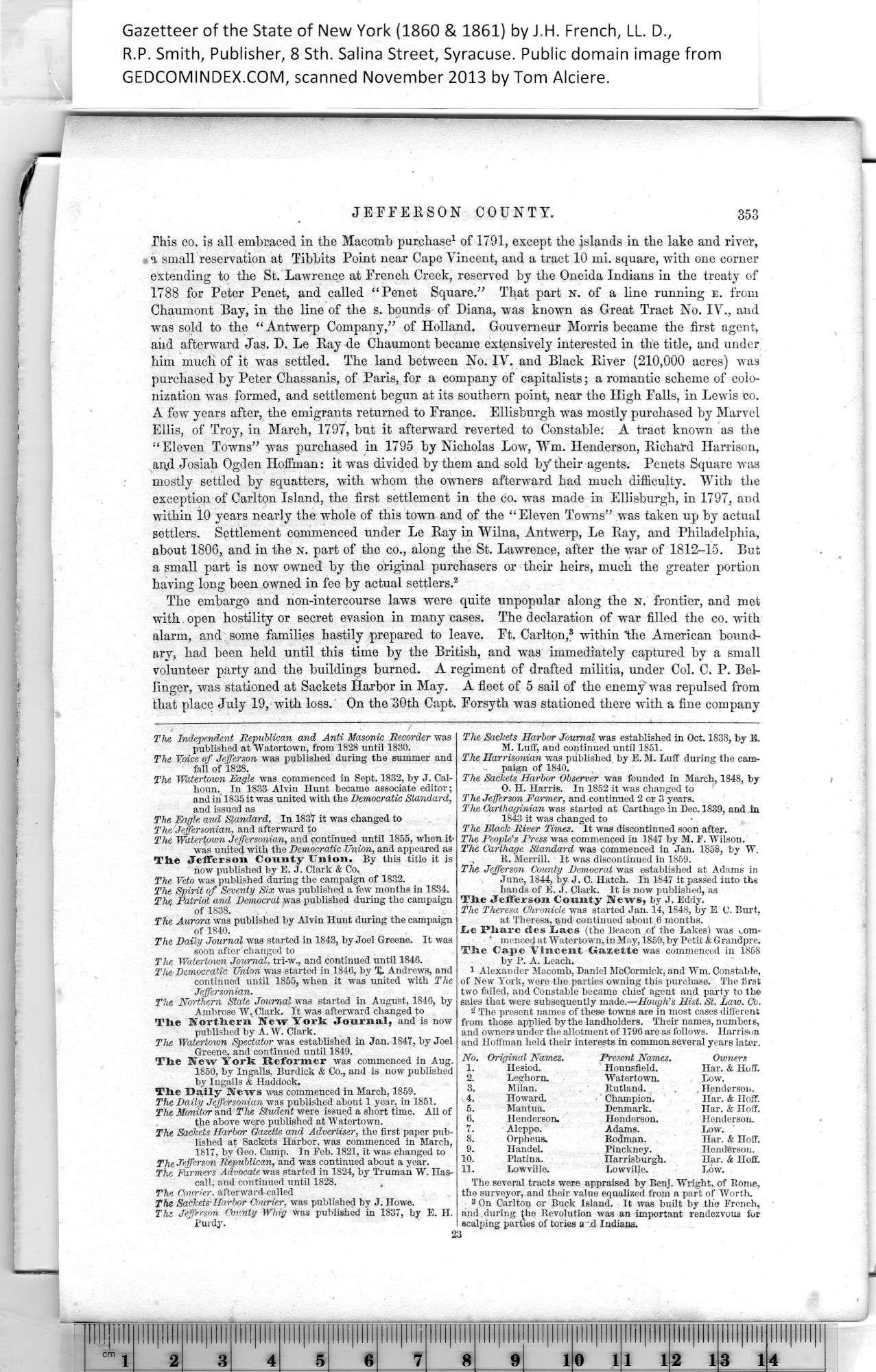|
/
The Independent Republican and Anti Masonic Recorder was
published at Watertown, from 1828 until 1830.
The Voice of Jefferson was published during the summer and
fall of 1828.
The Watertown Eagle was commenced in Sept. 1832, by J. Cal¬
houn. In 1833 Alvin Hunt became associate editor;
and in 1835 it was united with the Democratic Standard,
and issued as
The Eagle and Standard. In 1837 it was changed to
The Jeffersonian, and afterward to
The Watertown Jeffersonian, and continued until 1855, when it-
was united with the Democratic Union, and appeared as
Tlie Jefferson County Union. By this title it is
now published by E. J. Clark & Co.
The Veto was published during the campaign of 1832.
The Spirit of Seventy Six was published a few months in 1834.
The Patriot and Democrat was published during the campaign
of 1838.
The Aurora was published by Alvin Hunt during the campaign
of 1840.
The Daily Journal was started in 1843, by Joel Greene. It was
soon after changed to
The Watertown Journal, tri-w., and continued until 1846.
The Democratic Union was started in 1846, by X. Andrews, and
continued until 1855, when it was united with The
Jeffersonian.
The Northern State Journal was started in August, 1846, by
Ambrose W, Clark. It was afterward changed to
Tlie Northern New York Journal, and is now
published by A.W. Clark.
The Watertown Spectator was established in Jan. 1847, by Joel
Greene, and continued until 1849.
Tlie New York Reformer was commenced in Aug.
1850, by Ingalls, Burdick & Co., and is now published
by Ingalls & Haddock.
The Daily News was commenced in March, 1859.
The Daily Jeffersonian was published about 1 year, in 1851.
The Monitor and The Student were issued a short time. All of
the above were published at 'Watertown.
The Sackets Harbor Gazette and Advertiser, the first paper pub¬
lished at Sackets Harbor, was commenced in March,
1817, by Geo. Camp. In Feb. 1821, it was changed to
The Jefferson Republican, and was continued about a year.
The Farmers Advocate was started in 1824, by Truman W. Ilas-
call, and continued until 1828.
The Courier, afterward called
The Sackets Harbor Courier, was published by J. Howe.
The Jefferson County Whig was published in 1837, by E. H.
Purdy. |
The Sackets Harbor Journal was established in Oct. 1838, by E.
M. Luff, and continued until 1851.
The Harrisonian was published by E. M. Luff during the cam¬
paign of 1840.
The Sackets Harbor Observer was founded in March, 1848, by
O. H. Harris. In 1852 it was changed to
The Jefferson Farmer, and continued 2 or 3 years.
The Carthaginian was started at Carthage in Dec. 1839, and in
1843 it was changed to
The Black River Times. It was discontinued soon after.
The People’s Press was commenced in 1847 by M. F. Wilson.
The Carthage Standard was commenced in Jan. 1858, by W.
R. Merrill. It was discontinued in 1859.
The Jefferson County Democrat was established at Adams in
June, 1844, by J. C. Hatch. In 1847 it passed into the
hands of E. J. Clark. It is now published, as
The Jefferson. County News, by J. Eddy.
The Theresa Chronicle was started Jan. 14, 1848, by E C. Burt.
at Theresa, and continued about 6 months,
he Phare d.es Lacs (the Beacon of the Lakes) was com¬
menced at Watertown, in May, 1859, by Petit & Grandpre.
The Cape Vincent Gazette was commenced in 1858
by P. A. Leach.
1 Alexander Macomb, Daniel McCormick, and Wm. Constable,
of New York, were the parties owning this purchase. The first
two failed, and Constable became chief agent and party to the
sales that were subsequently made.—Hough’s Hist. St. Law. Co.
2 The present names of these towns are in most cases different
from those applied by the landholders. Their names, number s,
and owners under the allotment of 1796 are as follows. Harrison
and Hoffman held their interests in common several years later.
|
No. |
Original Names. |
Present Names. |
Owners |
|
1. |
Hesiod. |
Hounsfield. |
Har. & Hoff. |
|
2. |
Leghorn. |
Watertown. |
Low. |
|
3. |
Milan. |
Rutland. |
Henderson. |
|
4. |
Howard. |
Champion. |
Har. & Hoff. |
|
5. |
Mantua. |
Denmark. |
Har. & Hoff. |
|
6. |
Henderson. |
Henderson. |
Henderson. |
|
7. |
Aleppo. |
Adams. |
Low. |
|
8. |
Orpheus. |
Rodman. |
Har. & Hoff. |
|
9. |
Handel. |
Pinckney. |
Henderson. |
|
10. |
Platina. |
Harrisburgh. |
Har. & Hoff. |
|
11. |
Lowville. |
Lowville. |
Low. |
|
|
The several tracts were appraised by Benj. Wright, of Rome,
the surveyor, and their value equalized from a part of Worth.
8 On Carlton or Buck Island. It was built by the French,
and during the Revolution was an important rendezvous for
scalping parties of tories a vd Indians. |
|
